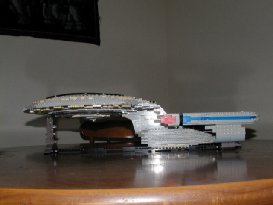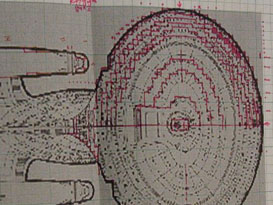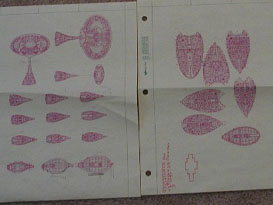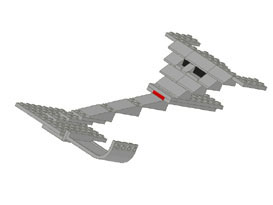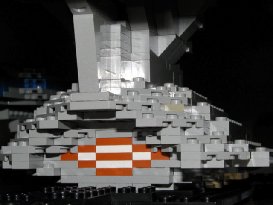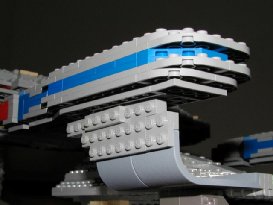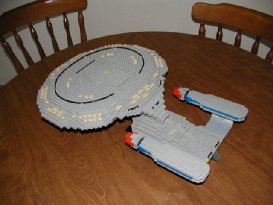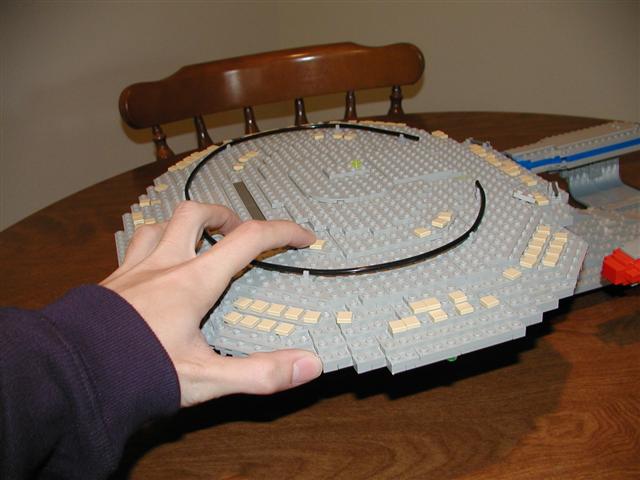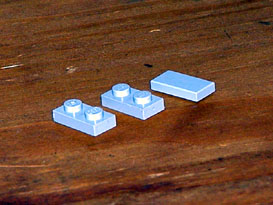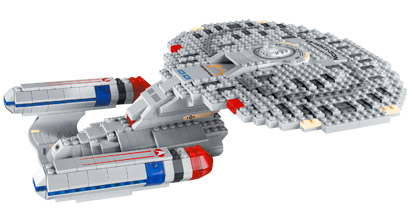Hello to the five or six of you who still happen to check this page, and thanks for the ongoing inquiries about this monster.
I'm happy to say that I'm about 70% done with the instructions for the Legoprise - everything except the saucer section, basically, which will be exceedingly hard to reconstruct. (First, my graph-paper plans were modified almost constantly as I put the thing together. Second, the internal support structure of the saucer was a completely spontaneous job. Third, I DON'T want to take the actual thing apart.) Rest assured, though, that once the MLCAD project is done, there will be a note here.
I've taken the break from Legos that I intended to take upon finishing the ship. 50,000 hits and a mention on Slashdot derailed that plan mighty quick. But since you were so nice to stop by, here's a peek at my next big Lego mosaic project.
When I got such an enthusiastic response about this model I said I was interested in selling. But then I actually got an offer, and I realized...not so much. At least not now. She needs to live on my shelf for another few months.
But bookmark this site, cause I do think I might put the LCAD files up in some sort of shareware form in the next couple of weeks. And as for the whole model? Well, keep checking Ebay...
A lot of people want to see what ELSE I've done with my Legos, when in truth there's not all that much. I mean seriously. I just took this one project and ran with it. But so you're not totally disappointed, I've uploaded a GIF of the Lego mosaic which hangs just by my front door. I'm NOT saying what it is. You have to figure it out. Bonus to the person who can find the original picture.
And check out my "Trip" pictures (linked from the front page) for a much better exhibit of my rudimentary photography skills. Just trying to get people to check out the rest of HappyWaffle.com, so long as I have your attention. :)
There's some unorganized notes and FAQs at bottom. Thanks for all the mail, yo. Even the ones that make fun of me. Especially the ones that make fun of me.
Alright, I'm a dork.
By sticking this project out on the Web I'm coming out of the closet, so to speak. I'm a classically trained geek-boy who has only enjoyed the company of women by the sheer grace of God. I might not be willing to touch a sci-fi convention with a 10-foot pole, but this work of dork-art more than makes up for it.
But I'm not here to tell you about my psychological issues. I'm here cause of this beauty.
The Concept
Having perused LUGnet and Brickshelf many times in the past, I was very, very surprised to find that not a single person has ever completed a project quite like this. Legos? Star Trek? Hell, it was a matter of time. I guess I was the chosen one. The idea itself was not all that revolutionary. One day I asked myself the age-old question: "If every floor of the Enterprise were one Lego-plate high, how big would that model get?" The answer was Pretty big, though as fate would have it, not so big that I was deterred from attempting the feat.
You want specifics? 50 studs wide, 69 studs long, and 43 plates high. That's 15-7/8" by 21-9/16" by 5-1/4". I'd tell you what the scale is, but funnily enough, I can't find the dimensions of the starship listed in my otherwise-invaluable Technical Manual. Ah well. Suffice it to say that at 42 stories tall, the real thing would smother downtown Austin.
(Note the discrepancy above? 42 decks, 43 Legos? That's cause all the documentation I found claims that the bridge is the same as Deck 1, when this cannot be the case if you count windows on the ship itself. I haven't quite figured out how this contradiction plays out in the published blueprints, but then I didn't put that much thought in it.)
My first attempt at planning this thing out involved scanning the overhead plan for the ship into my computer, resizing it appropriately in Photoshop, and printing it back out onto engineering graph paper such that each square on the paper corresponded to a 2x2 square of Legos. It was mostly guesswork at this point, and didn't have a good chance at making it any further than a pipe dream.
Then I found a Godsend, as far as the project went. In 1995 or so, a couple of the guys at Paramount were assigned to design the complete floor plans to the USS Enterprise, from decks 1 to 42. The result came in a big black box full of 22" x 34" poster sheets. My friend Winky owned a copy of these plans, which were a lot of fun to pore over, but much too big to do very much planning with. But here was the kicker: in 1998, another fellow scanned the enormous blueprint sheets into his Web site somehow. As a result, I found myself with a complete floor-by-floor map of how to build an Enterprise in Legos. (What had I gotten myself into?)
The Planning
One at a time, I downloaded the deck plans from the Web, resized them in Photoshop, and printed them out onto graph paper. I used good old pen and pencil to sketch out the "shape" of each deck on the graph paper, then started building the thing, using every gray Lego I could find. (At one point my supply of gray Legos seemed endless. No longer.) Work began at the very bottom, on deck 42, where the antimatter fuel is apparently stored. (Kind of a vulnerable spot for it, don't you think? What if they scraped against an asteroid or something?)
Before long, I started to employ the fantastic freeware Lego-design program, MLCAD, to brainstorm the next stages of my nascent project. At first I told myself that I'd model the whole thing in MLCAD and end up with a virtual Enterprise to match my actual Enterprise. Uh, I guess I got lazy. Or more truthfully, the actual design kept varying from what I designed onscreen. Every deck plan had to integrate nicely with the deck above and below it, so the thing could maintain its sturdiness. (This was especially important in the saucer section.)
As I sketched, I managed to use certain features of the ship as visual anchors, so that each deck design would be positioned correctly in relation to its neighbors. For instance, the warp engine itself is a column-shaped structure that stretches from deck 26 to 41, or so. Turbolifts were even more useful in this regard. Every deck plan on the graph paper has little red dots where the anchors are located, and I even inserted virtual posts into MLCAD so that I'd know where to place each new deck.
Construction, Construction
By the time I was up to floor 36 - that's the engineering deck, and the point where the warp nacelles are attached - I had completely run out of the gray Legos I needed. So I took to Ebay like a madman and started scooping up huge lots of gray Legos in every shape and size. Construction continued at something of a wacky pace, with frequent conceptual help from MLCAD, and more than one weeks-long break from work. I was definitely on no sort of deadline.
As I worked my way up the middle of the ship, I discovered Bricklink, an incredibly useful and cheap way to get exactly the Legos I needed for a certain little corner or angle of the ship. It proved especially handy when, for instance, I ran out of 4x6, 2x12, and 1x3 Legos. Click click click, and a few days later they were at my doorstep in bulk.
The deflector dish on the front of the ship - NOT the reflector dish, thank you very much - was a real headache. I'm still not completely satisfied with the result, but it's the best idea I could come up with, barring a rust-colored dish-shaped Lego I haven't heard about. In general, though, I was amazed at how a perfect Lego would pop up right when I was sure it wouldn't. The best example is the supports for the warp nacelles, technically known as Panel 3x4x6 with Curved Top. Their dimensions fit the shape of the "real" Enterprise perfectly. Any other size of Lego probably wouldn't have looked right.
Similarly, the angled pieces that Lego manufactures fit the dimensions of the ship's neck nicely, both front and back. I would typically build the decks using regular Lego plates and then go back through by hand and find places where a slope would fit into the plan. (When I discovered how well the neck was going to work out, I knew for the first time that this project really was going to be a reality.) The aesthetic result of all these slopes is kind of sleek, kind of choppy. I like it, though. My model sort of looks like Star Trek channeled through Star Wars.
In exactly one location - the warp nacelle supports - I broke some sort of unwritten moral code, which I later discovered some weenies take very seriously: I painted them gray from their original white, and glued them to their supports. In my defense, those pieces have never been manufactured in gray, and well, the nacelles were far too heavy to hold onto the ship's body by themselves. A liberal application of ABS plastic cement helped nicely.
The Minor Details
I built a Lego stand for the ship out of black and dark-grey Legos, pulled from the Lego TIE Interceptor set that I took apart awhile back. The lower section of the ship nestles nicely into it, and it supports the warp nacelles. The stand varies a little from the one pictured, mostly cause I realized the ship only needed one support tower to hold up.
To answer someone's question, this model is NOT very sturdy at all. Definitely not meant for the kiddies. See the FAQ below.
It was relatively late in the game that I decided I wanted more than a plain gray sculpture-model. The USS Enterprise has running lights, phasers, lifeboats, and hundreds of windows. Everything except the windows ended up being implemented somehow. Phasers were accomplished with Lego Technic pneumatic tubing that curved quite nicely. Unfortunately I could only find one length of the tube in dark gray, which was the color I really wanted. So that made up the lower phaser, and for the rest, black it was. Tan plates and tiles were similarly hard to find, to create all the little lifeboats. I ended up paying a ridiculous fee for some 200 tan Legos from a guy in the UK. I used only half of what I bought; the model looked too busy with all of them applied. But I never would have known without trying it out.
Even in this state, the ship is in progress, though I don't plan too much more work on it. The red "nose" of the warp nacelles got a slimming down which helped their look tremendously. I still want to replace the dark blue in the warp nacelles with a lighter, more "glowy" color, and I'm going to try adding more rust to the deflector dish so it's more round looking.
The Result
Let me toot my own horn: I think the thing is gorgeous, with a couple of quibbles. The "gooseneck" didn't turn out quite as gracefully as I would have liked. I followed the floor plans as exactly as possible, but it just didn't curve outward like I imagined. I could also use a better solution for the deflector dish, but no elegant idea popped out at me from the Legos available. Oh, and I would have loved to have translucent red and blue Legos in enough variety to make some pearly warp nacelles. Maybe next time.
But like I said, I'm quibbling. It is mostly perfect. In fact, thanks to the flexibility of Legos and some creative design work, I can say that the shape of my model varies from the one on TV by no more than 1/16th of an inch at any point. Scary, huh?
Having built the Enterprise from the keel up, I can say that the design is really...odd. The saucer section is just too damn huge, zero gravity or not. And why someone would design those giant warp nacelles up on skinny supports is beyond me. :) But who cares about reality? Truth is, it's a bloody gorgeous design I plagiarized here. Very much a work of art. (In some esoteric sense of the word.)
Notes and FAQs
- No, Wil Wheaton is not really my PR agent. That was a funny.
- I don't give a flying Fark whether it's Legos or LEGO or LEGOs or Laego or Lay-Go. Thanks for all the nice notes, though.
- Don't worry, I do leave the house, and I do many, many things besides play with Legos.
- My last personal note: I will never own or wear a Star Trek costume, and I actually like Star Wars better. But (a) the Enterprise is as graceful and sexy as anything ILM ever put out, and (b) Star Wars has been done, man.
- The sections of the ship are hollow, though the saucer is about 30% filled with support Legos in every color of the rainbow.
- As something of a wild guess, I'd say this took me about eight months from first sketch to final Lego, and something like 100 man-hours, which if you do the math is not all that much work per day. My work schedule was something like: two hours on, one week off, four hours on, five days off...
- I definitely spent more than $100, and probably less than $175.
- No clue how many Legos. Might finish the MLCAD version and make it available for sale sometime soon.
- Sure, after I've taken a break from it, I might go back and do the other Enterprises. But it won't be next week or anything.
- Within hours of posting, someone named Medic e-mailed me with the dimensions: "Enterprise-D is a Galaxy Class Starship, which are supposed to be 2,103 feet long by 1,542 wide by 476 tall." Which means, ratio-wise, my model is a little taller than it should be. I think I can live with that.
- Other than the swirls of paint and plastic cement, there is not a single non-Lego element in this model...though a few Mega Blox managed to sneak in here and there, I think.
- The model features accidental saucer-separation capability, as I've found out more than once.
- Is the gallery meant to be Mac propaganda? Well, if you see it and say to yourself "Wow, Macs let you make really easy Web galleries," then yes.
- Not interested in selling the whole model at any time soon. Maybe if my dining room table gets tired of it. Or the creditors come calling.
Resources
Thanks very much to the following books and Web sites for assistance:
- Star Trek Technical Manual—I bought this thing round about eighth grade and I'm as astounded now by its level of (invented) detail as I was then. More importantly, it was the first thing I cracked open when I needed a reference.
- Star Trek Blueprints—Meanwhile, without these things, the whole effort probably never would have happened...for a very long time, anyway. Thanks to Rick Sternbach for creating this box o' blueprints, and to Winky for letting me borrow his.
- USS Enterprise Navigation Control—Here's the scanned blueprints. Probably violates a copyright law or two. Regardless, thanks to the creator.
- MLCAD—Thank you, Mike, whoever you are. Who woulda thought you could design Lego sets on your computer? Brilliant stuff.
- LUGnet—A source of inspiration in seeing people who were crazier and more talented than I when it comes to these little bricks. Check it out. Some of the creations there make this beauty look like a two-day project.
- Peeron—A practically complete inventory of every Lego brick ever made, and what set it was used in. Scarily useful.
- BrickLink—The best place on the Internet to buy Legos. You want 225 gray 2x4 Lego plates? They're a Paypal click away.
- Ebay—Okay, okay, got some good stuff here too.
